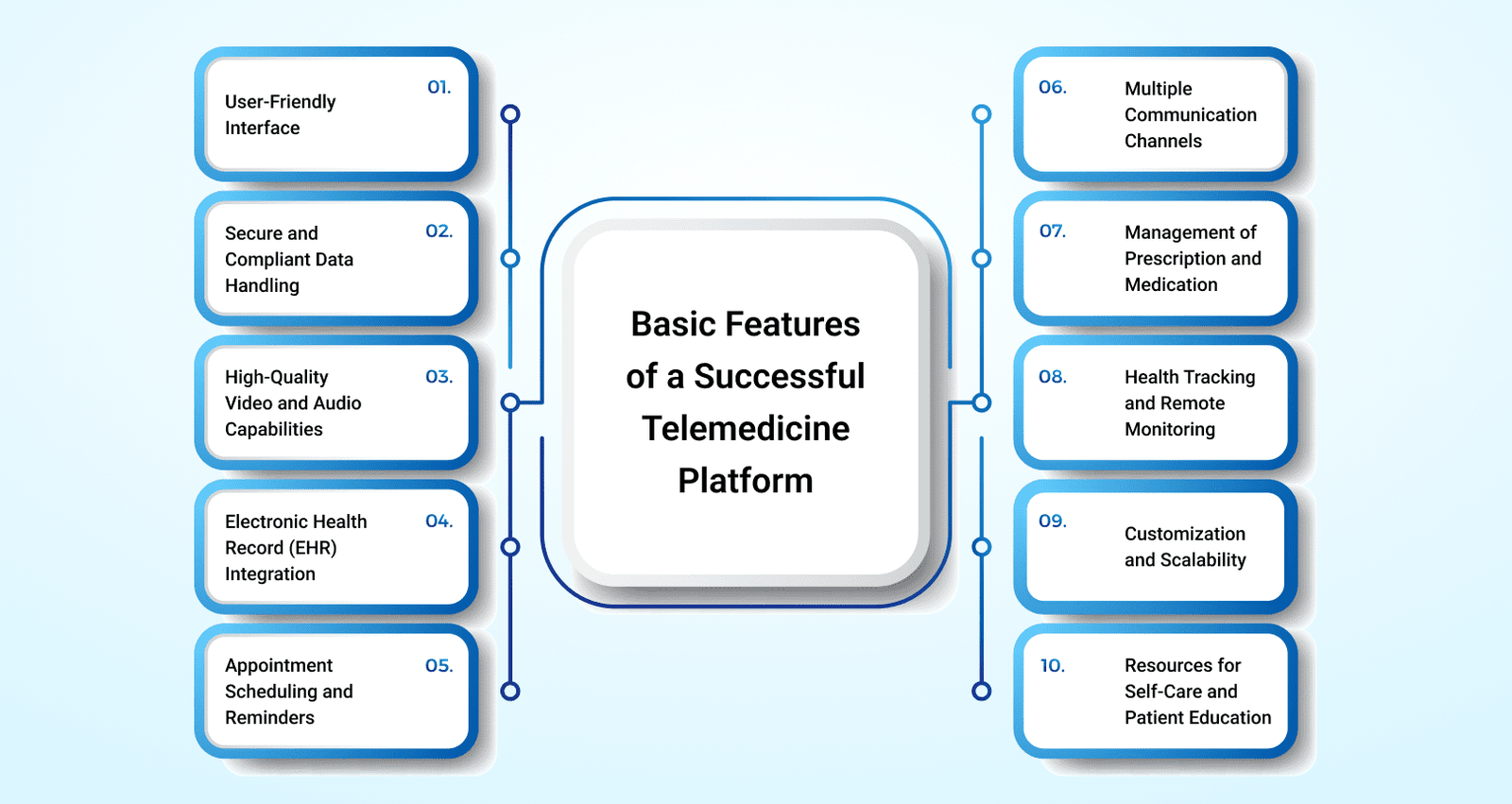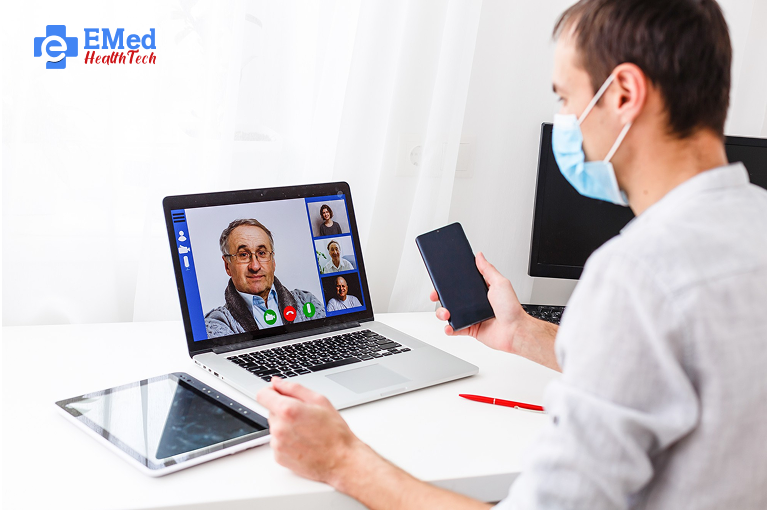Salim Chauhan
Telemedicine has grown to be a crucial component of contemporary healthcare, providing a more convenient and effective means of communication between patients and medical professionals. Understanding the essential components of a successful telemedicine platform is vital as the need for telemedicine develops.
These systems are the cornerstone for offering telehealth solutions, making telemedicine in healthcare possible, and enabling online telemedicine consultations. To guarantee peak performance, patient happiness, and overall success, we will examine the essential components of every telemedicine platform in this article.
 1. User-Friendly Interface
1. User-Friendly Interface
An effective telemedicine platform must put user-friendliness first. The platform should be easy to use for both patients and healthcare professionals. This functionality is crucial for enhancing user experience and guaranteeing easy access to telemedicine services for people of different ages and technological proficiency. Clear menus and easily available services, such as the ability to schedule appointments, make payments, and use virtual consultation tools, should all be included in the interface.
The platform should make it simple for medical professionals to access patient data, medical records, and diagnostic tools. This guarantees that they won’t have to worry about being hampered by complex software and can concentrate on providing high-quality treatment. A clear, straightforward interface lowers the learning curve, promotes user adoption of the telemedicine platform, and creates a happy environment for both patients and doctors.
2. Secure and Compliant Data Handling
A telemedicine platform’s data security and privacy are non-negotiable features. Sensitive personal information is trusted by patients with healthcare providers, and the platform has to be set up to manage this data appropriately. It is imperative to adhere to rules such as the Health Insurance Portability and Accountability Act (HIPAA) in the United States, the General Data Protection Regulation (GDPR) in Europe, and any other pertinent local legislation.
The platform should provide end-to-end encryption for all conversations, including text messaging, file transfers, and video consultations, to safeguard patient data. Only authorized personnel should have access to patient data, and multi-factor authentication should be used to provide further protection. Data security is a primary concern since data breaches can harm a telemedicine platform’s reputation in addition to having legal repercussions.
3. High-Quality Video and Audio Capabilities
The primary purpose of telemedicine systems is to provide remote consultations between patients and medical professionals. The platform has to have high-quality audio and video capabilities for this to work. Clear, continuous communication is essential for doctors to diagnose and treat patients effectively during telemedicine online sessions.
A dependable telemedicine platform needs to provide high-definition video transmission with little latency and crisp audio, even in locations with subpar internet access. To accomplish this, platforms need to include functions like adaptive bitrate streaming, which modifies the video quality according to the internet speed of the patient or provider, guaranteeing smooth consultations.
Furthermore, during consultations, video conferencing systems have to incorporate functionalities such as screen sharing, which facilitate healthcare practitioners to elucidate treatment plans, provide test findings, or distribute instructional materials.
4. Electronic Health Record (EHR) Integration
It should be possible for an effective telemedicine platform to easily interface with current Electronic Health Records (EHR) systems. During a telemedicine session, this integration gives medical professionals access to a patient’s full medical history, prior diagnoses, test findings, and current treatment regimens. Providers may deliver more knowledgeable diagnoses and treatments by guaranteeing this continuity of care, which eventually enhances patient outcomes.
Telemedicine solutions should provide the real-time sharing of medical documents, such as test results and prescriptions, in addition to EHR integration. With the help of this function, follow-up appointments and in-person visits are less necessary because everything can be handled digitally via the telemedicine platform.
5. Appointment Scheduling and Reminders
A simplified method for arranging appointments is one of the main components of any telemedicine platform. Via the platform, patients ought to have no trouble scheduling, changing, or canceling appointments with medical professionals. This helps healthcare practitioners better organize their calendars and increases patient satisfaction. Patients should be able to select from several time slots on the platform according to their availability.
Not only can automated reminders via email, SMS, or push alerts make scheduling simple, but they may also lower the amount of missed appointments. Reminding patients and healthcare providers of missed appointments can cause delays in patient care, so having a strong reminder system is crucial to a positive experience for everyone involved.
6. Multiple Communication Channels
A successful telemedicine platform to accommodate a range of patient demands and preferences offers many communication channels. For patients, video consultations are the main feature while phone conversations or text messages are sometimes preferred. It is ensured that patients may select the communication mode that best meets their needs at any given moment by providing a range of options.
For short follow-up queries, medication reminders, or communicating test results, text messaging may be quite helpful. For easier consultations or in situations when video is not available because of restricted internet access, some patients might also prefer audio calls over video. Multiple communication channels increase the flexibility and accessibility of telemedicine.
7. Management of Prescription and Medication
The capability of telemedicine platforms to remotely prescribe and administer medicines is a crucial characteristic. Healthcare professionals should be able to transmit patients’ electronic prescriptions to the pharmacy of their choosing or issue them directly to patients via the platform. This makes the procedure more comfortable for both patients and clinicians by doing away with the necessity for in-person encounters.
The platform should provide medication management capabilities, such as reminders for patients to take their prescribed drugs or refill prescriptions, in addition to e-prescriptions. These features guarantee that patients receive the prescription drugs they require promptly and enhance patient adherence to treatment strategies.
8. Health Tracking and Remote Monitoring
An aspect of telemedicine systems that is gaining popularity is remote patient monitoring (RPM), especially for the management of chronic illnesses. Real-time monitoring of a patient’s vital signs, including blood pressure, heart rate, and glucose levels, is made possible by RPM. Through the telemedicine platform, this data is instantly transmitted to the healthcare provider, enabling prompt actions as needed.
Remote monitoring may ease the minds of patients with long-term conditions or those recuperating from surgery, and it can assist medical professionals in identifying possible problems before they get worse. With this capability, the telemedicine platform becomes an invaluable tool for controlling chronic health disorders and improving patient care.
9. Customization and Scalability
Healthcare organizations’ requirements expand along with their growth. Scalability and customization are essential for a successful telemedicine platform to meet the changing needs of patients and healthcare professionals. The platform should be able to grow with the company, whether that means connecting with other health systems, supporting additional users, or introducing new features.
Healthcare providers may customize the platform to meet their unique requirements, whether it is branding, certain communication features, or specialty healthcare services. The capacity of the healthcare practitioner to provide high-quality treatment will be impacted throughout time by a platform that can adjust to changing requirements.
10. Resources for Self-Care and Patient Education
In addition to making consultations easier, an effective telemedicine online consultation should give patients access to learning materials. To help people understand their health issues, treatments, and preventative actions, this might include articles, videos, and self-care guidelines. Telemedicine systems can enhance patient involvement and adherence to treatment strategies by providing patients with knowledge.
Additionally, self-care resources like wellness trackers, symptom checkers, and mental health evaluations can give patients important information about their health in between appointments. The telemedicine platform’s total value is increased and proactive health management is encouraged by these technologies.
Transform Your Health Sector Today!
 Telemedicine will keep revolutionizing healthcare in 2025 and beyond by providing cutting-edge technologies that enhance patient care, accessibility, and convenience. High-quality communication capabilities, safe data processing, and user-friendly interfaces are essential components of any successful telemedicine platform. The platform’s efficacy is further enhanced by features like prescription management, remote monitoring, and EHR connection.
Telemedicine will keep revolutionizing healthcare in 2025 and beyond by providing cutting-edge technologies that enhance patient care, accessibility, and convenience. High-quality communication capabilities, safe data processing, and user-friendly interfaces are essential components of any successful telemedicine platform. The platform’s efficacy is further enhanced by features like prescription management, remote monitoring, and EHR connection.
Maintaining a competitive advantage in the evolving field of telemedicine will need the provision of different communication channels, scalability, and patient education tools. Purchasing a strong telemedicine platform may completely change the way medical professionals give treatment, increasing the effectiveness and accessibility of telemedicine in the healthcare industry.
EMedHealthTech specializes in bespoke telehealth solutions made to satisfy the demands of contemporary healthcare practitioners, whether you want to develop or improve your telemedicine platform. Get in touch with us right now to find out how we can assist you in developing a telemedicine platform that successfully changes patient care.
Related posts

Telemedicine
The Ultimate Guide to Telehealth App Development: How to Build a Telemedicine Application
The world of healthcare delivery is changing with the digital transformation. With the information age, where convenience and availability are paramount, the way people receive healthcare is evolving.
Read more
Telemedicine
How to Choose the Best Telemedicine App Development Company in the U.S.
Introduction The demand for telemedicine apps in the U.S. is at an all-time high, with healthcare providers rapidly adopting digital solutions to offer remote consultations and improve patient care. Choosing the right telemedicine app development company in the U.S. is crucial for ensuring seamless functionality, compliance with healthcare regulations, and a superior user experience. In […]
Read more
Telemedicine
Telemedicine in 2025: Top Mobile App Development Trends Shaping the Future of Healthcare
As we move into 2025, telemedicine is emerging as a key player in healthcare innovation. The rapid evolution of telemedicine app development redefines patient care and makes healthcare more accessible, flexible, and efficient.
Read more







